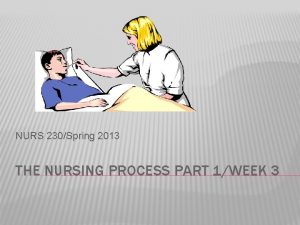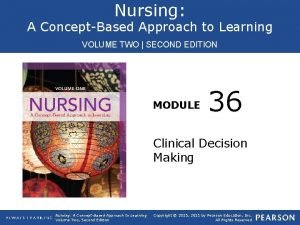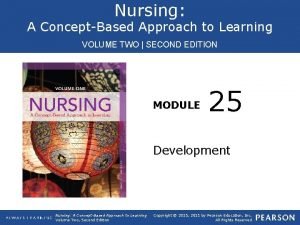MedicalSurgical Nursing An Integrated Approach 2 E Chapter





















- Slides: 21

Medical-Surgical Nursing: An Integrated Approach, 2 E Chapter 6 CULTURAL DIVERSITY AND NURSING

Culture and Nursing § Nurses provide health care to culturally diverse client populations in a variety of settings. § Knowledge of culturally relevant information is vital in the delivery of competent nursing care.

Culture § Dynamic and integrated structures of Knowledge, beliefs, behaviors, ideas, attitudes, values, habits, customs, languages, symbols, rituals, ceremonies, and practices that are unique to a particular group of people.

Ethnicity n A cultural group’s perception of itself, or a group identity.

Race n The grouping of people based on biological similarities.

Cultural Diversity n The differences among people that result from racial, ethnic, and cultural variables.

Important Terms in Cultural Diversity n n n Ethnocentrism: assumption of cultural superiority Oppression: result of ethnocentrism Stereotyping: the belief that all members of a cultural group act alike Dominant culture: prevailing group within a given society Minority group: those of fewer numbers Cultural assimilation: the absorption of the minority into the dominant culture

Components of Cultural Culture is composed of beliefs about: n n n Activity - how people organize and value work. Social relations - structure of friendships, gender roles and class. Motivation - the value and methods of achievement. Perception of the world - interpretation of life events and religious beliefs. Perception of self - refers to personal identity, value, and respect for individuals.

Characteristics of Cultural n n n Culture is learned Culture is not inherited or innate, but integrated throughout all interrelated components Culture is shared by all who belong to the cultural group Culture is tacit (unspoken) and understood by all in the cultural group Culture is dynamic

Cultural & Health Care How different cultures view the following variables affects health care in significant ways. n n Definition of health: what is it? Etiology: what are the origins of disease? Health Promotion and Protection: how is health achieved and maintained? Practitioners and Remedies: who and what can heal a person?

Cultural Roots § Unlike opinions, preferences, and attitudes, which can change, cultural characteristics are deeply rooted and difficult to change. § Clients reflect their cultural and ethnic heritage every time they interact with the world around them.

Cultural & Racial Influences on Client Care Culture and race influence client care in the areas of: n Communication n Orientation to Space and Time n Social Organization

Communication § Language differences can lead to misunderstandings and frustration. § Alternative methods of communication, such as flash cards and gestures, may have to be used. § Family members or staff interpreters may also be necessary to intercede.

Orientation to Space and Time n Issues around personal space and future orientation vary from culture to culture and impact the effective delivery of health care.

Social Organization Social organization refers to how different cultural groups determine rules of acceptable behavior. Examples include: Family Structure. n Gender Roles. n Religion. n

Religion § Culture is influenced by religion, which in turn affects beliefs and practices about health and illness. § Spiritual and religious beliefs are important in many people’s lives. They can influence lifestyle, attitudes, and feelings about illness and death.

Biological Variation § Biological variations distinguish one cultural or racial group from another. § Biological variations include skin color, hair texture, body structure, eye shape, etc. § Enzymatic differences account for diverse responses of some groups to dietary therapy and drugs.

Cultural Aspects & The Nursing Process n Cultural aspects affect all significant areas of the nursing process: assessment, nursing diagnosis, planning/outcome identification, implementation, and evaluation. Some areas are more affected than others.

Personal Cultural Assessment Five areas to be examined in assessing one’s own culture and the influence it may have on personal beliefs about health care are: n n n Influences from own ethnic/racial background. Typical verbal and non-communication patterns. Cultural values and norms. Religious beliefs and practices. Health beliefs and practices.

Client Cultural Assessment Six categories of information necessary for a comprehensive cultural assessment of a client are: n n n Ethnic or racial background. Language and communication patterns. Cultural values and norms. Biocultural factors. Religious beliefs and practices. Health beliefs and practices.

Culturally Appropriate Care n n n Respect clients for their different beliefs. Be sensitive to behaviors and practices different from your own. Accommodate differences if they are not detrimental to health. Listen for cues in the client’s conversation that relay a unique ethnic belief about etiology, transmission, prevention, etc. Teach positive health habits if client’s practices are deleterious to good health.
 An integrated approach to business studies
An integrated approach to business studies Lone star college nursing score sheet
Lone star college nursing score sheet Red rocks community college nursing
Red rocks community college nursing Datagram switching vs virtual circuit switching
Datagram switching vs virtual circuit switching Theoretical models of counseling
Theoretical models of counseling Shower approach marketing
Shower approach marketing Multiple approach-avoidance
Multiple approach-avoidance Bandura's reciprocal determinism
Bandura's reciprocal determinism Research approaches definition
Research approaches definition Traditional development approach
Traditional development approach Tony wagner's seven survival skills
Tony wagner's seven survival skills Cue cluster
Cue cluster Back channeling nursing
Back channeling nursing Nursing a concept based approach to learning volume 2
Nursing a concept based approach to learning volume 2 Nursing a concept based approach to learning
Nursing a concept based approach to learning Nursing a concept based approach to learning
Nursing a concept based approach to learning Team nursing model of care
Team nursing model of care Care plan on ocd
Care plan on ocd Nursing care plan for eye surgery
Nursing care plan for eye surgery Psychiatric nursing process
Psychiatric nursing process Nursing process in psychiatric nursing
Nursing process in psychiatric nursing Approach chemistry chalk chapter
Approach chemistry chalk chapter









































